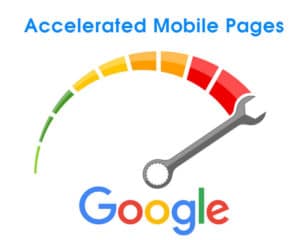Google AMP For Mobile – Everything You Need to Know
What is Google AMP?
In April 2016, Google launched Accelerated Mobile Pages or “AMP” that is intended to increase the speed time for loading mobile pages based on a new language library of AMP HTML, AMP JS (JavaScript) and AMP Cache. Google’s intentions or goal for AMP is to create a more friendly user experience by achieving an ‘instant’ load time on mobile devices because nearly 60% of searches occur on mobile. AMP is essentially a bare bones version of your main (desktop) website but to load faster and supposedly provide a better mobile user experience. However, with any new technology, there are many questions and concerns related to the impact of implementing AMP on your site. Let’s help clarify the confusion, excitement, and reality of AMP.
AMP HTMLIs essentially HTML with custom AMP properties that is fully supported in most browsers.
AMP JS Is essentially JavaScript with custom AMP properties that manages resource loading and provides custom tags to ensure a fast rendering/load time of pages.
Google AMP Cache Is a proxy-based content delivery network for delivering all valid AMP documents by fetching AMP HTML pages, caching them, and improving page performance automatically.
Why Google AMP?
According to Google, the median load time for mobile page (non-AMP) is 22 seconds versus the median load time for AMP-coded content is 0.7 seconds. However, take these results with a grain of salt as the adoption and implementation of AMP is not even a year old yet, so the median load time is expected to increase as more sites are converted to the AMP standard. Because, the ‘median’ load time is based on 125M+ documents indexed, across 640K+ domains versus the rest of the internet using a variety of different coding for mobile pages. This is why Google wants AMP to be adopted across the web for a better and more user-friendly mobile experience. Users want access to the information they are seeking quickly and immediately as well as the fact that mobile searches are almost 60% of total daily searches now.

How does AMP affect SEO?
Google claims that AMP will not directly impact search engine ranking factors for sites that adopt it or receive preferential treatment for receiving a ‘boost’ in search rank because they adopted AMP. However, this is a troublesome claim by Google, because of two factors that are in their search engine ranking algorithm. These factors are page load speed and bounce rate. Over the years, Google has specifically stated that if two identical websites were compared against each other, but one was slower, the faster one would be ranked above it. With bounce rate, the higher the bounce rate of a page, or even the website, the lower the ranking it would receive as Google would view this as ‘irrelevant’ to the users search. The reason these are two-fold for AMP pages is that bounce rate can be attributed to the speed of the page as people leave if it takes too long to load, which counts as a ‘bounce’ from the page. These things seem to already be the case with ranking factors. Since then, sites that have adopted AMP have seen a bump in their rankings and in the card carousel on Google Search results. As a result, many in the industry believe this is intentional by Google to push the adoption and implementation of AMP. However, Google has also stated that the card carousel layout may not always be in the Google search results. It’s currently being tested for usability and viability. So, if the card carousel ranking is your selling point, it would be advised to hold off from implementing AMP on your site.
Google AMP’s cons
With any new technology, there are challenges and limitations. This is currently the state of AMP as the limitations of the AMP platform is preventing many in the industry, from SEO’s to developers, from adopting the technology. AMP doesn’t allow them to achieve everything they want to accomplish on a mobile platform. These limitations should be considered if you are thinking about implementing AMP on your website.
Loss of Traffic
The biggest problem with those that have adopted AMP for their websites is that Google is essentially stealing traffic from their websites and pages. Because, with the Google AMP Cache, those pages are cached on Google’s servers and if someone clicks on it, or shares it (loss of viral potential), instead of being redirected to the optimized AMP version on the publisher’s server, it was actually being redirected to Google’s AMP Cache. Essentially, what is happening is that you publish/host a webpage and it appears in a Google search as your website for the search result. But, when the user clicks on that link, it appears in Google as a Google domain and Google puts their Google navigation at the top as well. This would both, directly and indirectly, take traffic away from your website, all because you adopted AMP.
Google states that they are looking into ways to make the source link more discoverable from the publisher, to retain branding and monetization control for the publisher, and will update AMP once they find a solution. For the mean time, visitors to the publisher’s AMP page can get to the homepage by clicking their logo (which rarely if ever occurs with visitor activity) and/or by having to code in an AMP Sidebar (even more implementation and coding work), for adding a menu to your AMP pages for visitors to navigate your website. This is not an ideal situation for websites that earn their revenue through traffic and advertising.
AMP Analytics
You will have to learn a new Google Analytics. Since AMP doesn’t support JavaScript (analytics.js), it uses JSON (JavaScript Object Notation) instead. This is because of AMP JS which limits the functionality of analytics data that can be collected on the site or page. Which, is limited to the following six analytic points:
-
- Page: domain, path, and page title
- User: Client ID and time zone
- Browsing: Referrer and unique page view ID
- Browser: screen height, screen width, and user agent
- Interaction: page height and page width
- Event: User interaction with content (downloads, ad clicks, video plays, etc.)
Duplicate Copy/Content of Every Page
AMP requires you to create a new AMP page for every HTML page that already exists. Therefore, you will have duplicate content which requires you to utilize the canonical tag to ensure you do not receive a duplicate content penalty from Google. The reason for this is because your AMP pages are actually on the Google AMP cache server and those pages have a completely different URL but is an exact replica of the original HTML page. Thus the importance of ensuring the canonical tags are implemented on your AMP pages.
However, it is unknown right now how other search engines, like Bing and Yahoo! will treat the AMP pages since AMP is Google’s programming language, but it is open-source and it is believed that the other search engines will be forced to adopt and recognize it, based on the participation and adoption rate of AMP pages across the web. The conflict is that Google is actually hosting the AMP pages on their cache server, which would cause traffic from Bing and Yahoo! To go to Google instead.That is if Bing and Yahoo! adopt the AMP pages for their mobile searches.
Implementation Time
This is discussed later in the “Questions to Ask Before Implementing AMP” section.

Google AMP’s pros
The pros for Google AMP pages are primarily all about speed and improving the user experience while on Google, as well as providing some benefits to the companies that implement AMP pages across their site for mobile.
Speed
The implementation of Google AMP pages decreases the page load time on mobile. As stated before, Google is touting the median load time for a mobile page (non-AMP) is 22 seconds versus the median load time for AMP-coded content is 0.7 seconds. This speed is achieved by having the web pages stripped down to their most basic forms of just plain HTML coding without the responsive aspects.
Increases Mobile Ranking (Temporarily?)
This doesn’t mean your mobile rankings will increase by solely implementing AMP, but it does help with your ranking factor because faster load times are a primary ranking factor for Google. So the potential is there to see increases in mobile ranking by switching to AMP. Along with that, if Google starts prioritizing AMPs in the future, which is already happening with AMP mobile pages being featured in the news carousels, it could have even more of an increase in ranking for mobile. However, the industry is wondering if this is a temporary boost in mobile rankings, as Google is just trying to emphasize the adoption of AMP pages, or if this is going to be a permanent change for mobile search results on Google. Only time will tell, but don’t solely switch to Google AMP Pages, solely for increasing your mobile rank if it doesn’t make strategic sense for you or your company.
Open-Source
Google has made the AMP language completely open-source, which allows public collaboration on the expansion of the AMP programming language. It also helps provide solutions to problems faster through the open source community, rather than later by waiting for Google’s team to resolve the issues. Along with this concept is that it provides a promising future for the development and expansion of AMP as anyone can test the language and add new features or functions to it, which would allow more people to adopt AMP as compatibility issues and blockers are addressed. Be it for analytics, conversion tracking or any other reason a company doesn’t want to switch to AMP right now, I imagine a lot of these issues will be addressed soon by Google or the open source community.
Google AMP pro or con?
Compete Against Facebook Instant Articles
There has been a debate going on in the industry about the pros or cons of Google AMP pages providing better content available for users and publishers versus“Instant Articles” on Facebook’s platform.
The pro argument is that Google AMP is providing the ability for publishers, and those adopting AMP, to make their content more widely accessible and have a wider reach in the search results, instead of just solely being on Facebook. It also allows the website to obtain the advertisement revenue, instead of it going to Facebook with their advertisements on their social platform. Essentially, Google is providing a CDN (content delivery network) for publishers and other websites, like blogs that rely solely on advertising revenue to remain operational.
The con argument is that while Google AMP is providing a CDN for publishers to compete against Instant Articles on Facebook, the AMP pages are being hosted by Google on their Google AMP Cache server. Which means that the websites with AMP don’t get the traffic accredited to their domain or website. This is major as traffic is a determining factor for how much a company makes on their advertising revenue, as the advertising amount is based on the volume of traffic coming to the website. It is believed that this could provide a ranking benefit for those sites on their mobile pages with the potential of a ranking increase. But, it could severely impact the long-term advertising revenue for publishers and websites that rely on this revenue for their company to remain operational. So, until Google figures out a way of allowing the traffic be accredited to these websites, this debate will remain throughout the industry.

Questions to ask before implementing AMP
1.) What percentage of traffic (how many visitors) coming to my site is/are mobile?
The only way to answer this question is if you have some type of analytics installed on your site that is tracking your traffic sources. That way you can look to see what percentage of traffic to your site is mobile, or in essence, the visitors that are using mobile devices when they visit your site to determine your return and benefit (time and cost of implementation) of installing AMP on your website.
2.) What is the load speed time of my website?
Determining the time it takes to load your website, should be a major determining factor for implementing AMP since Google uses the load speed time of a page and website as a ranking factor for their organic results. Therefore, you may want to implement AMP on your site, but only if your site is currently updated to the industry best standards. It would be wiser to spend your time and money on the implementation and development for an overall updated site for your website, that would have a mobile responsive design (following Google’s mobile-friendly guidelines), instead of investing in AMP. This investment would be better for your overall site user experience, whereas focusing on AMP would only benefit you for mobile speed.
3.) Is it worth the cost?
The implementation of AMP can be tedious and time-consuming depending upon your site. This is because AMP is a completely new programming language to the industry and has a restrictive framework, for example, it has only just allowed rudimentary forms and comment integration (for publishers) in the beginning of the year. With this restrictive framework, a majority of AMP implementation for sites has to be completed through custom development and coding. Granted, there are companies that have released plug-ins for WordPress and other Content Management Systems (CMS), but reports are that the plug-ins still require customized coding/programming to make it work on the specific site. This means that the cost of implementation for AMP would vary upon the size and scope of your website. But remember, with brand new coding languages, it is an opportunity for coders to ‘cash in’ on the projects.
The future of mobile web with AMP
With Google releasing AMP it is still uncertain how much this will impact mobile web. Since so many companies are either going through the process of upgrading their sites to the new industry standards of being responsive, have just completed this upgrade or are still saving up for development and implementation costs, many won’t find the cost of implementing and adopting Google AMP pages to their website feasible right now especially with it being in its infancy stages. The early-adopters of Google AMP will be the major companies and corporations, along with the large and dominate publishers as well as highly popular bloggers.
However, it is strongly believed that if Google and/or the developers using the open-source code for AMP are able to provide the majority of the functionality that doesn’t exist for AMP, but exists for mobile-responsive pages (i.e. analytics, conversion tracking, pixels, etc.), it will become a widely adopted across the industry. This is because it won’t be on a ‘proprietary’ platform like Apple News or Facebook with Instant Articles. However, it is unknown how long it will take to have those functions added to AMP’s language. Yet it is known that Google is working vigorously on a few of the most demanded elements, being forms, analytics and to repair the URL caching issue.
For the time being, it would be best to wait a few months and focus on continuing to develop and increase the performance of your already existing mobile pages, especially if they aren’t responsive yet. You should be prepared for making a priority AMP implementation list of your critical pages of your website, like the static pages (about us, contact us, info pages, blog posts, etc.) in case Google AMP is widely adopted and Google makes it a Web Standard. That way you can preserve your link equity and to maintain your ranking in the search results that you have worked so hard to achieve.
The conclusion is that it is strongly believed in the SEO community that since the majority of searches, roughly 60% are being conducted by mobile devices and with Google slowly transitioning the primary index from desktop to mobile, Google AMP is going to become a heavily influenced ranking factor as ‘speed’ or ‘page load time’ is becoming more prevalent as people on mobile don’t want to wait longer than 3 seconds for the page to load. It is a strong belief that AMP will be the future of mobile search for Google.
Lastly, Google AMP is the fun, exciting and new technology right now that is causing many questions and concerns throughout the industry. Hopefully, this post helped provide clarity and at least some guidance on what to do for you and your company.

Additional questions
Contact us to learn more about Google AMP and how your website could benefit from professional digital marketing services after Google’s launch of AMP.
Ready To Grow?
Let's Talk!


